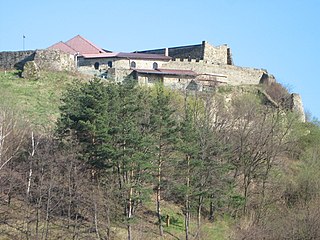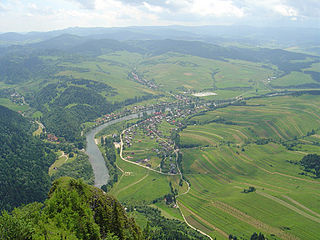
Princess Teofila Ludwika Zasławska was a member of the Polish nobility, known as the perhaps most significant heiress and landowner of her contemporary Poland.

Pieniny National Park is a protected area located in the heart of Pieniny Mountains in the southernmost part of Poland. Administratively, the Park lies in the Lesser Poland Voivodeship on the border with Slovakia. Its head office is in Krościenko nad Dunajcem.

The Nowy Sącz Royal Castle is a mediaeval castle in the city of Nowy Sącz in Poland. The partially restored ruins of the castle date back to the 14th century during the reign of Casimir III the Great.

Zakliczyn is a town in Tarnów County, Lesser Poland Voivodeship, Poland, with 1,558 inhabitants (2006). Zakliczyn lies on the right bank of the Dunajec river, surrounded by wooded hills 300 to 500 metres above sea level. Zakliczyn has a town hall, located in a spacious market square, one of the largest in the province, at 100 by 170 metres. The town was originally called Opatkowice; its name was changed in 1558, in honor of the village of Zakliczyn, Myślenice County, which was ancient seat of the Jordan family.

Wąsosz is a town in Góra County, Lower Silesian Voivodeship, in south-western Poland. It is the seat of the administrative district (gmina) called Gmina Wąsosz. It lies approximately 17 kilometres (11 mi) south-east of Góra, and 53 kilometres (33 mi) north-west of the regional capital Wrocław. The rivers Orla and Barycz meet here.

The Trail of the Eagle's Nests of south-western Poland, is a marked trail along a chain of 25 medieval castles between Częstochowa and Kraków. The Trail of the Eagles' Nests was first marked by Kazimierz Sosnowski. Since 1980, much of the area has been designated a protected area known as the Eagle Nests Landscape Park.

Tenczynek Landscape Park is a protected area in southern Poland, established in 1981, and covering an area of 117.47 square kilometres (45.36 sq mi).
The Dunajec river castles is a chain of thirteen medieval castles, built in southern Lesser Poland, along the Dunajec river. The castles protected the border between the Kingdom of Poland and the Kingdom of Hungary, as well as a very important international merchant route, which went along the Dunajec and the Poprad. Most of the castles are in ruin now, some of them do not exist any longer. Their history of most castles dates back to the period known as fragmentation of Poland, when, following the Testament of Bolesław III Wrymouth the country was divided into several provinces. The Dunajec river castles were located on the territory of two castellanies, Wojnicz and Nowy Sącz, in extreme south of the Seniorate Province.

Kraków Mydlniki is a railway station in the Bronowice district of Kraków, Poland, located in the neighbourhood of Mydlniki, northwest of the city centre. The station, with its historic building, lies within the Tenczynek Landscape Park protected area with numerous summer visitors, because the Park is also the location of a medieval Tenczyn Castle built as a seat of the powerful Tęczyński family. It fell into ruin during the Deluge in mid-17th century, after being pillaged and burned by Swedish-Brandenburgian forces looking for the Polish Crown Jewels and the rumored treasures of the Tęczyński family. Within the Landscape Park are five nature reserves.

Gołuchów Castle is an early Renaissance castle built between 1550-1560 on a square plan and used as a defensive stronghold and residence. The castle is located in Gołuchów, Greater Poland Voivodeship; in Poland.

Grodno Castle is a castle located in the southern parts of the Wałbrzych Mountains, on the Choina Mountain, standing to the left of the river Bystrzyca. The valley of this river, formerly known as the Silesian Valley, creates a natural boundary between the Owl Mountains and to the west of it the Wałbrzych Mountains. The castle is located in Zagórze Śląskie, Lower Silesian Voivodeship in Poland.

Dobczyce Castle is a castle in Dobczyce, Lesser Poland Voivodeship, in southern Poland. It is located on a rocky hill above Lake Dobczyce. The castle was first mentioned in written sources in 1362, but had been fortified since 1311. In the time of Casimir III the Great, the walls were from 5 to 9 meters thick, and the castle was a fortified stronghold. In 1398, the castle was the abode of King Władysław II Jagiełło and his wife Jadwiga. In 1473, for several months, Prince Casimir stayed here after returning from an unsuccessful expedition.

Lębork Castle - a castle built by the Teutonic Order located in Lębork, Pomeranian Voivodeship. The building is found on the river Łeba.

Olsztyn Castle – castle ruins located in the Kraków-Częstochowa Upland, lying on the Trail of the Eagles' Nests – formerly protecting the southern border of the Kingdom of Poland. The ruins of the 14th-century castle are one of the biggest attractions of the area.

Drzewica Castle - a Gothic-Renaissance castle built between 1527 and 1535 by Archbishop of Gniezno Maciej Drzewicki. The Archbishop built the castle on the peripheries of the town, by the river Drzewiczka and encircled the fortress with moats, separated by a bulwark. The building's plan is based on a regular rectangular shape. Its defence systems are based on four square towers located in each corner of the castle. The building burned down in 1814, remaining a well preserved ruin. Thus, the castle did not undergo any later modifications, remaining one of Poland's best preserved residences from the first part of the sixteenth-century.

Kazimierz Dolny Castle - originating from the thirteenth and fourteenth-century, Romanesque castle ruins located in Kazimierz Dolny, Lublin Voivodeship in Poland.

Rabsztyn Castle - Gothic castle ruins located in the Kraków-Częstochowa Upland, part of the Eagles' Nests castle system, found in the village of Rabsztyn, Lesser Poland Voivodeship in Poland.

Bąkowiec Castle - fourteenth-century knight's castle ruins, located in the Kraków-Częstochowa Upland. The fortress was built as part of the Trail of the Eagles' Nests defence system, located in the village of Morsko, Silesian Voivodeship in Poland.

Bydlin Castle - fourteenth-century castle ruins, located in the Kraków-Częstochowa Upland. The fortress was built as part of the Trail of the Eagles' Nests defence system, located in the village of Bydlin, Lesser Poland Voivodeship in Poland.
























